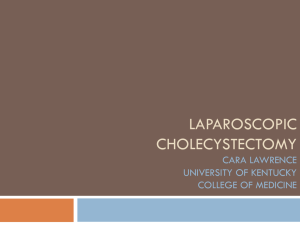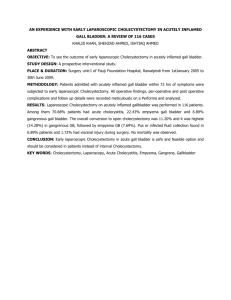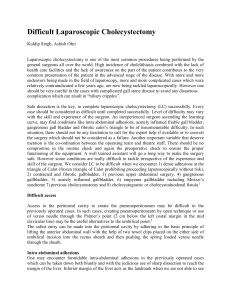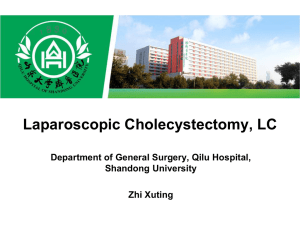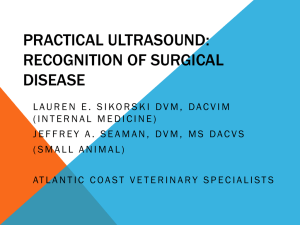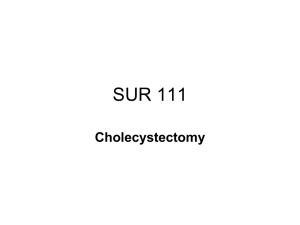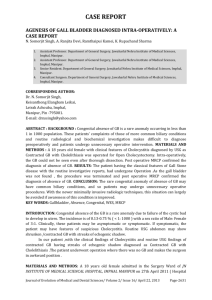107_eposter - Stanley Radiology
advertisement
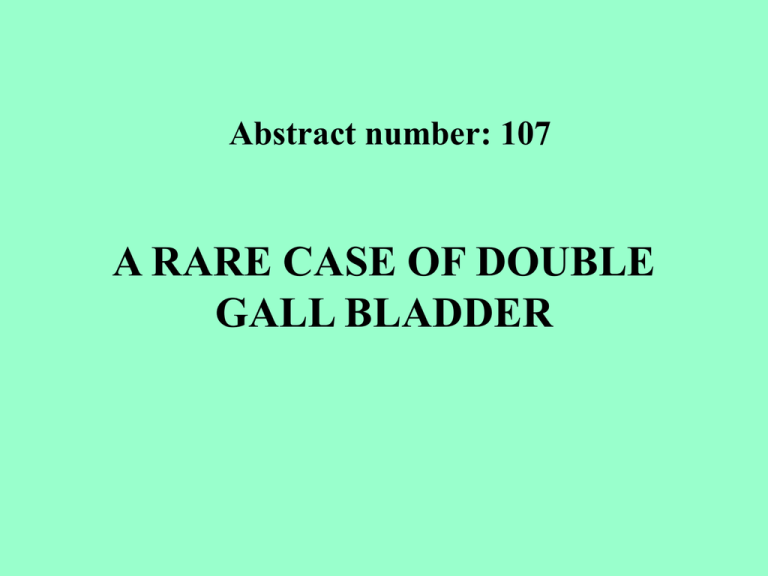
Abstract number: 107 A RARE CASE OF DOUBLE GALL BLADDER CASE HISTORY • A 60 year old female patient who was asymptomatic and walked in for master health checkup. • On ultrasound abdomen , incidentally she was found to have double gall bladder. • Findings were reconfirmed with CT and MRCP. ULTRASOUND ABDOMEN • Two oblong anechoic structures closely abutting each other noted in the gall bladder fossa. • No other associated abnormalities noted. ULTRASOUND ABDOMEN CT AND MRCP • Subsequently CT and MRCP were performed which revealed complete duplication of gall bladder with a single cystic duct (Type I duplication of Boyden’s classification) without any co-existing pathology. AXIAL CT CORONAL CT SAGITTAL CT T1 AXIAL MRI T2 AXIAL MRI T2 CORONAL MRI MRCP 3D Lt Hepatic MPD CBD DISCUSSION • Double gallbladder is a rare congenital anomaly • Boyden has classified double gallbladder into two types; • Type I: Vesica fellea divisa (Bilobed / bifid gall bladder, double gall bladder with a common neck) • Type II: Vesica fellea duplex (Double gall bladder with two cystic ducts) - Y shaped in which two cystic ducts are united before entering the common bile duct - H shaped in which two cystic ducts enter separately in to common bile duct or hepatic duct. DISCUSSION • Classification by Harlaftis et al is based on morphology and embryogenesis of two main groups and a third miscellaneous group. • The former is characterized by the presence of a single cystic duct entering the common bile duct (Type l, that is split primordium group). • The accessory gallbladder group is characterized by two cystic ducts opening separately into the biliary tree (Type 2, that is accessory gallbladder group). • The last is Type 3, the miscellaneous group which does not fall into the foregoing two types DIFFERENTIAL DIAGNOSIS • - Differential diagnosis include Gall bladder diverticula Gall bladder fold Phrygian cap Choledocal cyst Pericholecystic fluid CONCLUSION • Congenital anomalies of gall bladder and anatomical variation of their positions are associated with an increased risk of complications after laparoscopic cholecystectomy. • Preoperative imaging should be useful for diagnosis. CONCLUSION • Double gall bladder duplication is a rare congenital anomaly. • In case of any complications such as calculi, complete pre operative assessment is mandatory to prevent any inadvertent surgical complications. • In asymptomatic patients surgery is not required. REFERENCES 1. 2. 3. 4. E. A. Boyden, “The accessory gallbladder: an embryological and comparative study of aberrant biliary vesicles occuring in man and the domestic mammals,” American Journal of Anatomy, vol. 38, pp. 177–231, 1926. F. Borghi, G. Giraudo, P. Geretto, and L. Ghezzo, “Perforation of missed double gallbladder after primary laparoscopic cholecystectomy: endoscopic and laparoscopic management,” Journal of Laparoendoscopic and Advanced Surgical Techniques, vol. 18, no. 3, pp. 429–431, 2008. P. R. Kothari, T. Kumar, A. Jiwane, S. Paul, R. Kutumbale, and B. Kulkarni, “Unusual features of gall bladder duplication cyst with review of the literature,” Pediatric Surgery International, vol. 21, no. 7, pp. 552–554, 2005. M. Pitiakoudis, N. Papanas, A. Polychronidis, E. Maltezos, P. Prassopoulos, and C. Simopoulos, “Double gall-bladder—two pathologies: a case report,” Acta Chirurgica Belgica, vol. 108, no. 2, pp. 261–263, 2008. REFERENCES 5. R. Udelsman and P. H. Sugarbaker, “Congenital duplication of the gallbladder associated with an anomalous right hepatic artery,” American Journal of Surgery, vol. 149, no. 6, pp. 812–815, 1985. 6. Gigot J, Van Beers B, Goncette L, Etienne J. Collard A, Jadoul P, Therasse A, Otte JB,Kestens P. Laparoscopic treatment of gallbladder duplication-A plea for removal of both gallbladder. Surg Endosc 1997; 11; 479-82. 7. Ozgen A, Akata D, Arta A, Demirkazik FB, Ozmen MN, Akhan O. Gallbladder duplication: imaging findings and differential considerations. Abdom Imaging 1999; 24; 2858

